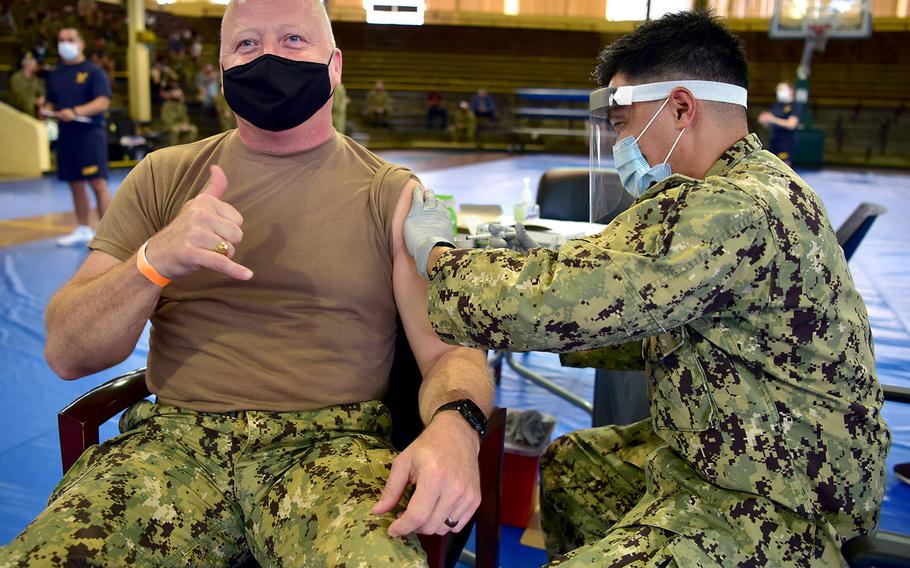
U.S. Pacific Fleet Fleet Master Chief James Honea receives the coronavirus vaccine at Joint Base Pearl Harbor-Hickam in Hawaii on Dec. 29, 2020, from Hospital Corpsman 2nd Class Philip Sayma, assigned to Navy Environmental and Preventative Unit 6. Naval Health Clinic was one of the facilities selected to receive the vaccine in a phased and coordinated strategy, prioritizing the vaccine for eligible personnel to protect their health, families, and communities. (Jay C. Pugh/U.S. Navy)
Stars and Stripes is making stories on the coronavirus pandemic available free of charge. See other free reports here. Sign up for our daily coronavirus newsletter here. Please support our journalism with a subscription.
WASHINGTON — All but three Navy bases have reinstated their travel restrictions due to the coronavirus pandemic, the Pentagon announced Wednesday as military infections surpass 105,000.
As of Monday, 59 out of 62 naval bases had travel restrictions reinstated, according to a Pentagon document released Wednesday. The only U.S. naval bases that have lifted their travel restrictions are located overseas: Naval Station Rota in Spain, Naval Station Guantanamo Bay in Cuba, and Naval Support Activity Bahrain.
Travel restrictions were first put into place in March to try to prevent the spread of the virus within the Defense Department. Then-Defense Secretary Mark Esper signed a memorandum May 22 that laid out the conditions needed for locations to allow for travel to and from bases. The restrictions have impacted the military moves of service members and their families during the past several months, causing backlogs during the busiest moving season for the military.
As of Monday, 91 of 231 U.S. military installations around the world, or 39%, had lifted their travel restrictions for personnel, according to the document. The last time there was that few bases open for travel was July 13.
The military reached the most open bases on Nov. 4 at 153 out of 231, or 66%, according to the Pentagon. Since then, more installations have had to reinstate travel restrictions as coronavirus cases have risen during the holiday season and cooler weather.
The other services have different proportions of their installations restricted or open to travel. Of the Air Force’s 80 installations, 45 have lifted restrictions as of Monday, according to the Pentagon. The Army only has 28 of its 68 installations open. The Marine Corps has lifted restrictions at 14 of its 17 installations. Of the four remaining Defense Department installations — three finance centers and the Pentagon — only the Pentagon has lifted travel restrictions.
As of Wednesday, the Pentagon reported a total of 105,871 service members have tested positive for the coronavirus, 931 have been hospitalized, 68,049 have recovered, and 14 have died.
The Army still has the largest share of those cases with 37,736 soldiers infected, according to the Pentagon. The Navy has had 22,225 cases, the Air Force has had 19,520, and the Marine Corps has had 12,763 cases. The National Guard has reported 12,897 cases among its service members.
The United States has surpassed 19.6 million cases of the virus as of Wednesday, the most reported cases of any country, according to Johns Hopkins University. Behind the U.S. is India, which has reported 10.2 million cases, and Brazil with 7.5 million cases. The United States also has the highest number of people to die from the coronavirus at 340,956 as of Wednesday. Brazil has lost 192,681 people to the virus and India has lost 148,429 people.
Kenney.Caitlin@stripes.com Twitter: @caitlinmkenney